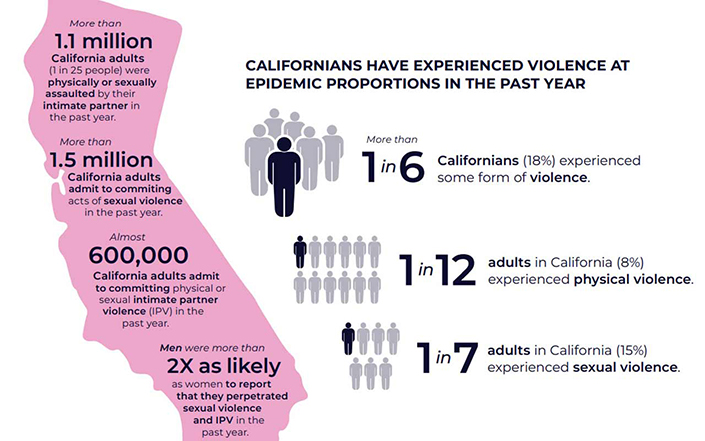Violence is Common and Increasing in Pandemic-Era California
In a new report, UC San Diego researchers label physical and sexual violence a state ‘epidemic;’ call for health equity-based reform
Story by:
Published Date
Article Content
Violence is on the rise in California, with significant increases observed during the COVID-19 pandemic, according to the latest annual report from the California Study on Violence Experiences across the Lifespan (CalVEX). Led by researchers at University of California San Diego School of Medicine, CalVEX is the nation’s only multi-year statewide assessment of violent experiences.
The findings, shared in a public report on September 8, 2022, reveal that more than one in six Californians (18 percent) experienced physical or sexual violence in the past year, and one in every 25 Californians experienced intimate partner violence. Rates of both physical and sexual violence have increased since the start of the pandemic, with physical violence nearly doubling for men from 2020 to 2022. Further demographic disparities highlight potential contributing factors that may have been exacerbated by the pandemic.
“Californians are experiencing violence at epidemic proportions,” said principal investigator Anita Raj, PhD, professor at University of California San Diego School of Medicine and Division of Social Sciences. “Current violence prevention efforts are clearly woefully inadequate and often ignore the gendered nature of violence, its intersections with other socioeconomic vulnerabilities and its disproportionate effects on marginalized populations.”
The majority of victims never formally report these experiences, so researchers say relying on criminal justice data or health records to examine the state of violence often fails to capture the true breadth of abuses. Instead, CalVEX surveys a representative sample of adults across the state and uses their responses to estimate population rates. Data in the latest report were collected in March 2022 from 2,285 adults.
The results reveal various gender disparities in the experience and perpetration of violence. Men are more likely than women to have faced physical violence, whereas women are more likely than men to have experienced many forms of sexual violence. While more than 1.5 million adults in California admit to committing acts of sexual violence in the past year, men were more than two times as likely as women to report that they perpetrated sexual violence and intimate partner violence.

Women also showed greater mental health impacts and life disruptions due to violent experiences, with 82 percent of women reporting anxiety or depression as a result of physically aggressive, coercive or forced sexual behavior. Women who reported physical violence were also twice as likely as men to miss work or school as well as change or quit a job.
Socially and economically vulnerable Californians — including Latino and Black communities, LGBTQ communities, people with a history of homelessness or incarceration, and people living with a disability — also faced disproportionate levels of violence. Experiences of financial distress, including eviction and food or housing insecurity, were associated with a two to eight times increased risk of violence.
“Our findings suggest the rising rates of violence are linked to the harsher social climate, economic insecurity, and poorer physical and mental health that many Californians have experienced over the last few years due to the pandemic,” said Raj.
The researchers advocate for new policies that strengthen social and economic safety nets, programs in violence prevention, and mental health services across the state. Such a multi-level approach, Raj says, would not only address the current violence crisis, but also support post-pandemic rebuilding and make the state more resilient to other health, environmental and socioeconomic stressors to come.
Co-authors of the report include Nicole E. Johns, Nabamallika Dehingia, Wendy Wei Chang and Jennifer Yore, all at UC San Diego.
This research was funded, in part, by the Blue Shield of California Foundation (grants RP-1907-13755 and P-2006-14747) and Kaiser Permanente National Community Benefit Fund at the East Bay Community Foundation (grants 20202903 and 118910).
Share This:
Stay in the Know
Keep up with all the latest from UC San Diego. Subscribe to the newsletter today.



